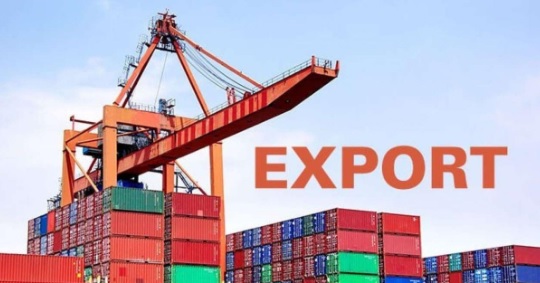(Prelims: Current Events of National Importance, Economic and Social Development)
(Mains, General Studies Paper 3: Topics Related to Indian Economy and Planning, Resource Mobilization, Growth, Development, and Employment) |
Context
Amidst growing global trade uncertainties and the imposition of a 50% tariff on Indian goods by the US, the Union Cabinet has approved a comprehensive Export Promotion Mission (EPM) worth ₹25,060 crore.

About the Export Promotion Mission
- The Union Cabinet has approved the Export Promotion Mission (EPM), which was announced in the Union Budget 2025-26.
- It is a major initiative to strengthen India's export competitiveness, especially for MSMEs, first-time exporters, and labor-intensive sectors.
Features of the Export Promotion Mission
- It will provide a comprehensive, flexible, and digitally driven framework for export promotion.
- It will be operated with a funding of ₹25,060 crore for the period 2025-26 to 2030-31.
- It marks a strategic shift from multiple fragmented schemes to a single, results-based, and adaptable mechanism.
- Its collaborative framework includes the Department of Commerce, Ministry of MSME, Ministry of Finance, and other key stakeholders. Its implementing agency is the Directorate General of Foreign Trade (DGFT).
- It consolidates key export support schemes such as the Interest Equalization Scheme (IES) and the Market Access Initiative (MAI) and aligns them with contemporary trade needs.
- The scheme will provide priority support to sectors affected by the recent global tariff increases, such as textiles, leather, gems and jewellery, engineering goods, and marine products.
Sub-Schemes under the Export Promotion Mission
- Export Promotion: This focuses on improving access to affordable trade finance for MSMEs through various instruments such as interest subvention, export factoring, collateral guarantees, etc.
- Export Direction: This focuses on non-financial enablers that enhance market readiness and competitiveness, such as export quality and compliance assistance, support for international branding, packaging, export warehousing and logistics, etc.
Background of the Scheme – Tariff Pressure and Export Slowdown
- The United States, India's largest export destination, has imposed a 50% tariff effective August 27, 2025, making Indian goods among the most taxed goods globally after China.
- India's exports to the United States declined by 12% in September 2025. Engineering goods declined by 9.4%.
- 28% of textile and apparel exports go to the US, which declined by 10.34% year-on-year in September 2025.
- The government's initiative, the Export Promotion Mission (EPM), is a strategic response to protect jobs, maintain export momentum, and diversify into new markets.
Objectives of the Export Promotion Mission
- To help exporters, especially MSMEs. Increasing credit availability and reducing credit costs
- Addressing non-tariff barriers, logistics constraints, branding and market access challenges
- Enabling diversification into new and high-risk markets
Implementation Framework for the Export Promotion Mission
- The Directorate General of Foreign Trade (DGFT) will manage the mission, which will be implemented through two sub-schemes:
- Export Promotion (₹10,401 crore): Focuses on financial interventions and includes interest subvention, export factoring, credit guarantees, credit cards for e-commerce exporters, and credit enhancement tools. It aims to improve access to trade finance and working capital liquidity
- Export Direction (₹14,659 crore): The focus will be on non-financial interventions and will include international branding, packaging, trade fairs, warehousing, logistics support, inland transport reimbursement, and capacity building initiatives.
- Digital and Flexible Framework: This mission provides a digitally driven, comprehensive, and flexible framework to meet contemporary trade needs and align export support with dynamic global conditions.
Other Cabinet Decisions Related to This
- The ₹20,000 crore Credit Guarantee Scheme for Exporters (CGSE) aims to provide additional working capital and collateral-free credit to exporters up to 20% of the sanctioned limit.
- Its coverage includes 100% guarantee by the National Credit Guarantee Trustee Company (NCGTC) to lending institutions. This includes MSMEs. Exporters, including the Ministry of Textiles and Textiles, are beneficiaries, and its validity is until March 2026.
- It is expected to enhance liquidity, support diversification, and ensure smooth business operations.
Sectoral Impact and Stakeholder Reactions
- Textile and Apparel Sector: The Confederation of Indian Textile Industry (CITI) welcomed the mission, stating that it will make Indian textiles globally competitive and help leverage free trade agreements (FTAs) for market expansion.
- MSME Empowerment: The Federation of Indian Export Organisations (FIEO) praised the integrated financial and non-financial framework of the EPM, stating that it addresses long-standing challenges such as high compliance costs, weak branding, and logistics inefficiencies.
- Gems and Jewellery Sector: The Gems and Jewellery Export Promotion Council (GJEPC) appreciated measures such as interest subvention and expanded trade fair support, calling them crucial for first-time exporters and MSMEs.
Indian Export Performance
- Overall Growth: India's total exports (goods and services) grew by 5.19% in April-August 2025 compared to the same period last year.
- Total Value: The combined export value in April-August 2025 was US$ 346.10 billion.
- Merchandise Exports: During April-August 2025, it witnessed a growth of 2.31%, reaching US$ 183.74 billion.
- Non-petroleum and non-gems and jewellery exports: It registered a robust growth of 7.76%, reaching US$ 146.70 billion during the same period.
- Growth Drivers: Key sectors contributing to growth include engineering goods, electronics, pharmaceuticals, and chemicals.
- Challenges: The goods trade deficit widened (in September 2025) due to a faster increase in imports compared to exports.
Way Forward
- Strengthening Trade Finance: Ensuring timely and affordable credit access for MSMEs through digital platforms
- Enhancing Market Intelligence: Creating a data-driven mechanism to identify new export destinations
- Promoting Brand India: Investing in global marketing, packaging, and e-commerce support
- Addressing Structural Bottlenecks: Improving Logistics Infrastructure and Reducing Compliance Burdens
- Leveraging FTAs: Leveraging Existing and Upcoming Trade Agreements to Expand Export Markets



